‘Dodgy dossiers’? Hearsay and the 1641 Depositions
Published in 1641 Rebellion, Confederate War and Cromwell, Cromwell, Early Modern History (1500–1700), Features, Issue 3 (May/June 2011), Volume 19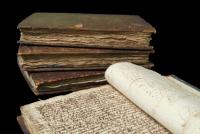
Four of the 31 bound volumes of the 1641 Depositions, comprising c. 8,000 witness statements, 20,000 pages and about 2.7 million words of newly digitised and transcribed testimony, originally collected by government-appointed commissioners, regarding the rebellion by the Catholic Irish in 1641. These statements constitute the chief evidence for the allegation that the rebellion began with a general massacre of Protestant settlers, and they have been central to a protracted and bitter historical dispute. (Trinity College, Dublin)
‘How lies about Irish “barbarism” in 1641 paved way for Cromwell’s atrocities. Conference hears how seventeenth-century “dodgy dossier” spread stories about Catholics ripping open pregnant Protestant women.’
These headlines appeared in the Guardian On-line in February 2011. The ‘dodgy dossier’ angle was a good headline-grabber, but the truth of the matter is that the Language and Linguistic Evidence in the 1641 Depositions project has a long way to go in considering the role of hearsay in witness testimony. The project was funded by the UK Arts and Humanities
Research Council to enable a team of researchers from a number of disciplines—historical linguistics, forensic linguistics, computer science and history—to begin work on analysing the 1641 Depositions held by Trinity College, Dublin, which had recently been digitised by a team from Trinity, Aberdeen and Cambridge University. In stark contrast to the Guardian headline, when the digitisation project finished to great fanfare in October 2010 the following headline appeared in the Irish Times in reference to the stripping and drowning of about 100 men, women and children in Portadown, one of the most terrible atrocities in Ireland’s history: ‘Witnesses to mass murder in the icy Bann’. (In fact there was only one witness to that event.)
So are the Depositions based on lies or on real witness testimony? And how does the Language and Linguistic Evidence project contribute to our understanding of events during the 1641 rebellion and after? Indeed, the question might be posed differently: what can the work of a language-focused team tell us about the Depositions that historians do not know already? In order to understand what the Aberdeen-based 1641 project has done and what we are planning to do in the future, it is important to understand what we set out to do in the first place.
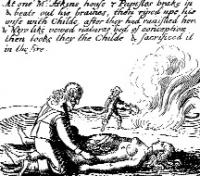
‘At one Mr Atkins’ house the Papists brake in and beate out his braines, then riped upe his wife with childe after they had ravished her, and Nero-like viewed nature’s bed of conception, then tooke they the childe and sacrificed it in the fire’—James Cranford’s The Teares of Ireland (London, 1642). According to Nicholas Canny, ‘these gory narrations, detailing supposed brutal murders, and the ripping of babies from the wombs of pregnant women, are of historical value if only because they convey some sense of the terror which gripped the minds of the settlers as word reached them of the breakdown of authority in several parts of the country’. (Trinity College, Dublin)
Aims of the project
We intended to develop a suite of innovative software designed for both linguistic analysis and the meaningful and accessible display of results that would allow us to interrogate the whole Depositions corpus about a range of linguistic issues. In cooperation with IBM Dublin, we adapted IBM’s LanguageWare natural language-processing software to find out about the nature of the language it contains, given that it represents Early Modern quasi-legal language. We also looked at how we can adapt sophisticated forensic and critical linguistic analysis, which is used on contemporary English, to investigate how language in the period served legal, political and religious agendas, and to understand the language of conflict in the corpus.
Our main aim was to develop a website—a Collaborative Linguistic Research and Learning Environment (CLRLE)—that would allow researchers, students and interested members of the public to sort, search and analyse the whole corpus to answer a variety of language-based questions; for example, finding out what words for household goods and chattels appear in the corpus would tell us something about seventeenth-century life and culture. For the author, a historian of the language, an important question was what Early Modern English looks like in the corpus. Is the grammar the same as or different from other Early Modern English dialects? Is there any evidence of ‘colonial overlay’ in the language, as in, say, American English of the period?
Much more challenging is the question of how credible these witness statements are. Can we distinguish directly reported incidents and eyewitness accounts from hearsay, i.e. reports of reports? And can we detect the influence of the clerks and the commissioners in the ‘manipulation’ of the evidence? These are hugely important questions, given that the Depositions have been hotly disputed as evidence for the allegation that the massacre of Protestants was premeditated.
But hearsay in the Depositions is not a new issue. In 2001 Nicholas Canny observed:
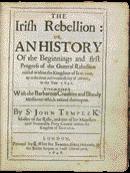
John Temple’s The Irish Rebellion substantiated its arguments through providing printed (and edited) abstracts of the 1641 Depositions. (Trinity College, Dublin)
‘Besides . . . personal testimony of what they had seen, heard and experienced, many deponents also supplied accounts of what had been reported to them by other victims of the attack, frequently from places far removed from where they themselves resided. This hearsay evidence often enters the realm of the fantastic and, in subsequent years, was frequently extracted from the depositions to spice the Protestant printed accounts of the insurrection. Such material cannot be accepted as evidence that these reported events ever occurred, even if the veracity of the narratives went unquestioned by those who came forward to make depositions, as it was by those who assembled the sworn testimony. However, even these gory narrations, detailing supposed brutal murders, and the ripping of babies from the wombs of pregnant women, are of historical value if only because they convey some sense of the terror which gripped the minds of the settlers as word reached them of the breakdown of authority in several parts of the country . . . the Irish terror of 1641 must be scrutinised, not least because it influenced how Protestants behaved once such rumours reached them.’
The newly digitised 1641 Depositions corpus, coupled with the 1641 CLRLE interface, allows us to look closely, systematically and exhaustively at the language in which such witness statements are phrased, using established linguistic methods that are founded on tried and tested linguistic theories and backed up with reliable statistical and documentary evidence (each example is traceable to the original manuscript and thus interpretable in context). Crucially, this sort of semi-automated analysis enables complex careful searches within hours and days, rather than the months and years it took for historians to work through original manuscripts, with the attendant problems of deciphering handwriting, interpreting scribal conventions and compensating for missing or spoiled text. The heroic efforts of the original 1641 transcription and digitisation team, headed by Professor Aidan Clarke, boosted by the 1641 CLRLE website, which allows for sophisticated searching and analysis, puts the entire 1641 Depositions corpus literally at our fingertips.
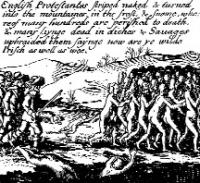
What do linguists do?
So what exactly do linguists do? Dr Nicola MacLeod, a forensic linguist, tackled the hearsay question and investigated the source or evidential basis of witness depositions. To begin the comparison between events that were reported in eyewitness accounts and those that arose from hearsay reports, she selected the verbs sawe and heard that as a point of departure and subjected the corpus to analysis using the Wordsmith tools cited on the 1641 CLRLE website. The tables below show the frequency of the right-hand collocates (or the words that appear most frequently immediately to the right) of sawe, as tallied by Wordsmith Tools.
The table shows that a frequent right-hand collocate of sawe is the apparent synonym observed. On examining the pertinent lines in the original texts, a familiar stylistic feature of legalese emerged, the apparently redundant use of binomials (cf. saw and observed, goods and chattels, deposeth and saith). The frequency of binomials across the corpus indicates a formulaic institutional influence on the documents: that is, it suggests that they have been affected by the legal reporting system. The table below shows the most frequent 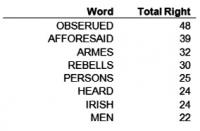 right-hand collocates for heard that:
right-hand collocates for heard that:
A simple comparison of the tables demonstrates that more obvious items relating to violence are associated with the hearsay marker than with the eyewitness marker.
A further indicator of hearsay as a basis for report is the verb informed. Of 974 total occurrences of informed, 458 were immediately preceded by credibly. The frequent use of credibly here indicates awareness on the part of commissioners and/or scribes—both of whom were government representatives—that hearsay was disfavoured by the law (since in English law a witness normally needs to be present in order to allow for examination and cross-examination), so that efforts were made to enhance the reliability of this kind of evidence, the adverb credibly serving this function.
Macleod’s research shows that the overwhelming tendency is for informed to appear in passive constructions, e.g. ‘this deponent was credibly informed’, with no mention of the ‘informer’, i.e. the
 original witness. If the ‘informer’ is indeed omitted, responsibility for the utterance is obscured, and the utterance has no discernible source. Indeed, examination of occurrences of informed showed that only 225 out of the 974 were followed by by, indicating the original ‘informer’. And even when the informer is given, it is a 50–50 split between named sources and people or groups who would be impossible to trace on the basis of their description: divers of the neighbours, papists there, several who was present, one whose name he knows not, etc. Thus it appears, according to Macleod, that when it came to allowing hearsay evidence, the source or originator of the account was not as important as its being labelled credible.
original witness. If the ‘informer’ is indeed omitted, responsibility for the utterance is obscured, and the utterance has no discernible source. Indeed, examination of occurrences of informed showed that only 225 out of the 974 were followed by by, indicating the original ‘informer’. And even when the informer is given, it is a 50–50 split between named sources and people or groups who would be impossible to trace on the basis of their description: divers of the neighbours, papists there, several who was present, one whose name he knows not, etc. Thus it appears, according to Macleod, that when it came to allowing hearsay evidence, the source or originator of the account was not as important as its being labelled credible.
Snobbery and hearsay
The analysis of the nature of the evidence in the Depositions has just begun and the above example was intended to be illustrative rather than an exhaustive account of what a linguist can do. And we need to stress that the Aberdeen project was interdisciplinary—that is to say, we wanted collaboration and knowledge exchange between linguists and the representatives of other discipline on the project (and beyond). To illustrate the importance of this, we emphasise that our understanding of witness credibility can be enriched by socio-historical insight into early modern society.
Dr Eamon Darcy of Trinity College, Dublin, a historian, shows that the 1641 Depositions contain numerous examples of how both Catholics and Protestants denigrated one another’s social station, raising the question of whether reports or statements from the gentlemanly ranks were given preference over those from the less-well-off members of society. Darcy notes that in his preface to The Irish Rebellion, a history that substantiated its arguments through providing printed (and edited) abstracts of the 1641 Depositions, John Temple, the author, went to great lengths to describe the standing of deponents:
‘The persons examined were of severall conditions, most of them British, some of Irish birth and extraction, very many of good quality, and such as were of inferiour rank were not rejected if they were known sufferers, and came freely in to declare what they speak of their owne knowledge.’
As Darcy observes:
‘Understanding contemporary perceptions of [the Depositions’] reliability cannot simply focus on the eye-witness versus hearsay divide. Those involved in their collection were keen to stress that some of the hearsay evidence came from reliable sources. These reliable sources were either people of higher social ranks, or those who lived among the rebels. The Catholic Confederation of Kilkenny charged [commissioner] Jones and his colleagues with taking “every hearsay as positive truth”. Jones responded (albeit privately): “neither do we take hearinge for positive truth to but leave to ye reader to consider of it as is presented: neither are all heresays to be cast off especially beeing delivered by credible persons and upon oath”. (TCD, MS 840, f. 19v)’
Temple later clarified this and argued that:
‘What is given in by them [the deponents] upon hearsay, they for the most part depose, that they received it out of the Rebels own Mouthes while they were in restraint among them.’
Both Temple and Jones argued that the hearsay evidence was from reliable sources, in terms of either their social rank or their experience of the rebellion. Darcy also considers the issue of the deponents mentioning incidents that were credibly reported to them. He points out that these reports were sometimes attributed to ‘people of good repute in their communities and those from the higher social orders’. Within some of the depositions, Darcy points out, the deponents specified the source of what they heard:
‘For example, Henry Alyffe, a self-described gentleman and a settler living in King’s County was interrogated by John Sterne and John Watson. Alyffe described in great detail his losses and his experience of the rebellion. Let us not forget, the depositions were also an intelligence gathering operation. Alyffe duly supplied his questioners with all he had heard as well as witnessed. The king’s army were in Mullingar he reported, but he had heard this from “beggars in patched cotes”. Later he testified that a meeting had taken place in Multifarnham that was attended by hundreds of priests and friars. The commissioners recorded that “he heard it avouched and spoken by men not of the meanest qualitie in these parts of the irish”. Local magnates were incredibly annoyed with the powerful role of the clergy in organising the war effort, according to Alyffe. “This deponent heard many gentlemen of great meanes of the irish papists say it was counterfeited & curssed the fryers to their faces for it saying if it were not for their habitt, they would run them thoroughe with their skeanes.” Here deponents recognised the different grievances that prompted the various social orders to take up arms in 1641 and 1642.’
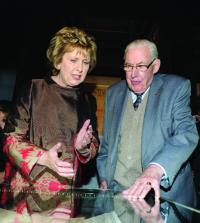
President Mary McAleese and Revd Ian Paisley at the launch of the ‘Ireland in Turmoil’ exhibition centred on the Depositions, in the Long Room, Trinity College, on 22 October 2010. (Paul Sharpe)
Such observations remind us that we cannot simply interpret text that we find according to modern standards of proof and modern concepts of credibility and reliability, but that it needs to be seen through the historian’s lens. We all use language as our raw material but, to put it simply, the linguist has her tool-kit, and the computer scientists and historians have theirs, and the richest interpretation of a complex historical source is collaborative. While computer-aided analysis allows us to consider vast amounts of material that perhaps would take a lifetime to deal with manually, it does not take away the need for domain-specific knowledge, for interpretation and for intellectual exchange. We have only just begun to re-examine the question of the credibility of the Depositions as evidence; the digitisation of the corpus and the development of dedicated software will assist our endeavours, but the debate will rage for years to come. HI
Barbara Fennell is Principal Investigator of the Language and Linguistic Evidence in the 1641 Depositions project at the University of Aberdeen.
Further reading:
N. Canny, Making Ireland British, 1580–1650 (Oxford, 2001).
A. Clarke, ‘A Discourse Between Two Councillors of State, The One of England, And The Other of Ireland (1642)’, Analecta Hibernica 26 (1970).
















